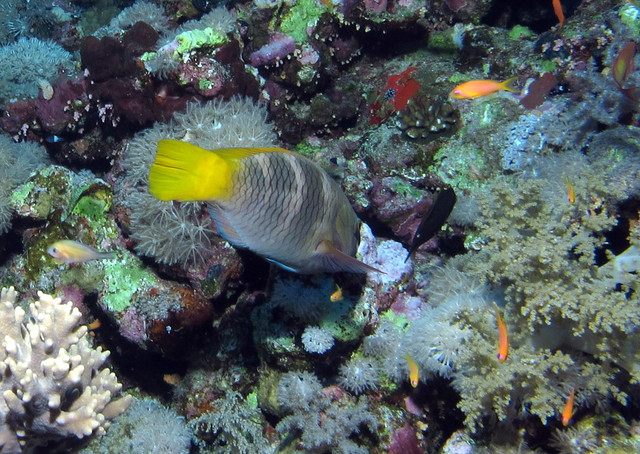Biological destruction of coral reefs is something
that is incredibly important to consider. The major agents of this kind of
destruction can be divided into grazers, etchers, and borers. Grazers are
animals such as echinoderms and a wide variety of fish. These organisms graze
on live or dead coral substrates, encrusting coralline algae, tufted or
filamentous algae which grows on hard reef substrates. They do this action in
order to search for food or to produce a cavity in which to give them
protection against predators or wave action (Hutchings 1986). A picture of an example of this is seen below in Figure 1:

Figure 1. "Fish in Coral Reef".
Etching is done by bacteria,
fungi, and algae. Etching is a means of penetrating coral substrates. It has
also been shown that bacteria may be involved in the breakdown of limestone
surfaces. More work is needed to document the destructive role of bacteria in
the field as well as calcite (Hutchings 1986). An example is seen below in Figure 2:

Figure 2. "Fungi on Coral Reef".
Borers bore holes into plant material and corals.
Sponges are a huge culprit of this. The importance of sponges in the processes
of erosion, sediment production, and calcium carbonate dissolution was not
realized until the late 1960’s. Most of the evidence of this was found in
Bermuda by a scientist names Rutzler in 1974. Bivalve molluscs are also
perpetrators of this action. They bore into rock, coral, and shell and this
action is well developed within the three families of bivalves. They use
mechanical means of penetration into rock. Sipunculans are endolithic animals
which are found in many reef areas. They bore into live and dead coral but also
limestones in both intertidal and subtidal zones. Studies of this organism’s
boring strategy in the Caribbean, specifically in Belize. Two scientists, Rice
and MacIntyre did these studies in the Caribbean and they discovered that six
of eight recorded species were borers in coral substrate (Hutchings 1986). An example is shown below:

Figure 3. "Sponge on Coral Reef".
The impact of bioerosion is extremely complex and hard
to determine fully for scientists. Corals are one of the richest and diverse
marine ecosystems known to man.
Bioerosion is responsible for the creation of a large number of reef
habitats. Each reef habitat is characterized by its own community. Bioerosion, when
paired with physical erosion, is responsible for the creation of newly
available substrates which is caused by weakened coral colonies becoming
dislodged during storms. Small scale disturbances have been important in
maintaining the species diversity of coral reefs. Though bioerosion may sound
like a negative thing, the activities of many bioeroders actually encourage and
help facilitate reef growth (Hutchings 1986).
Every group discussed above attributed to the rates of
bioerosion. There are some limitations in some measurements dealing with these
organisms. There is also some variability in rates of bioerosion both over time
and space. Bioerosion is a major factor which influences reef morphology. Through
the few quantitative estimates of rates, it spears that bioerosion is a major
component of the total erosional modification of reefs. When this is paired
with the chemical and physical erosion, this facilitates the formation of
characteristic reef structures. These structures include boulder tracts, eroded
reef flats, and sediments. Bioerosion also may be very important in maintaining
the high diversity of coral reefs which can be seen mostly on protected leeward
reefs. Bioerosion is a very important source determining the shape and form of
coral reefs, although it is a very neglected one. This is a topic that will hopefully
be taken into more comprehensive studies in the future.
Research Paper Source:
Hutchings, P. 1986. Biological Destruction of Coral Reefs. Coral Reefs. 4, 4:239-252. https://www.researchgate.net/publication/226779075_Biological_destruction_of_coral_reefs_a_review-Coral_Reefs4_239-252_Berlin
Picture Sources:
"Fish in Coral Reef." Bing, Microsoft, Images. 13 February 2018.
"Fungi on Coral Reef." Bing, Microsoft, Images. 13 February 2018.
"Sponge on Coral Reef." Bing, Microsoft, Images. 13 February 2018.
This is an interesting post. I didn't know bioerosion was so beneficial to coral reefs! Something to look into after reading this could be how ocean acidification and coral bleaching affects these grazers, borers, and etchers. Perhaps it doesn't affect them because they can eat dead coral substrates?
ReplyDeleteI had never heard of the term bioerosion, so I thought this post was very interesting. I can see how the interactions of grazers, borers, and etchers with the coral are important in the coral reef ecosystem and help determine reef morphology. Although your post mainly looks at the positive effects of bioerosion, I wonder what kind of negative effects there can be, such as the results of too much bioerosion, and how bioerosion might be affected by climate change.
ReplyDeleteWhen you hear about coral reefs there is ususally only mention of the biodiversity and how it is being changed by climate change and coral bleaching, it is interesting to hear about a different, lesser known aspect. Bioerosion seems to be a highly beneficial to the surrounding ecosystem in the long run which makes me ask the question, if these creatures are speeding up coral reef destruction, are they really hurting themselves in the long run?
ReplyDelete